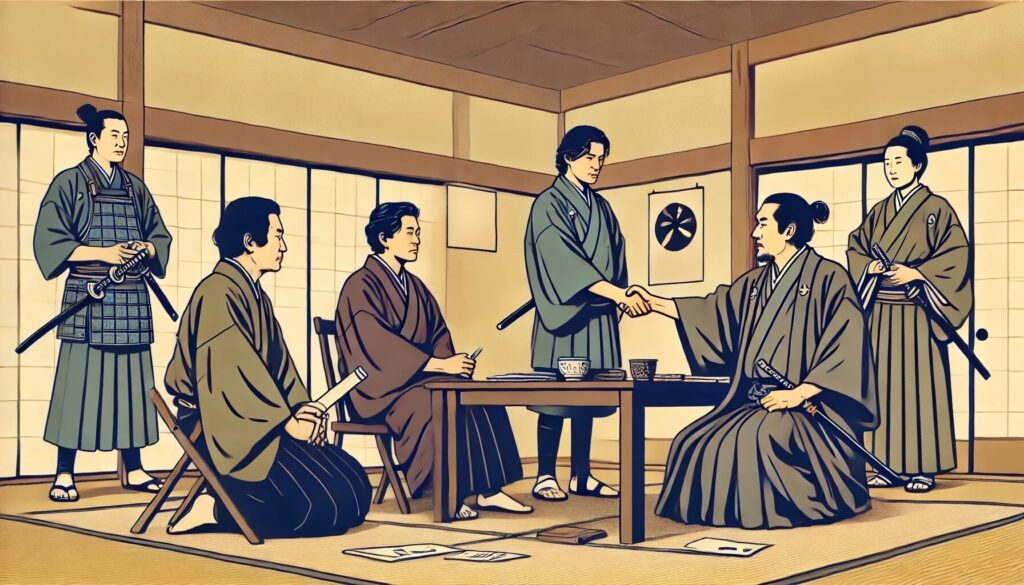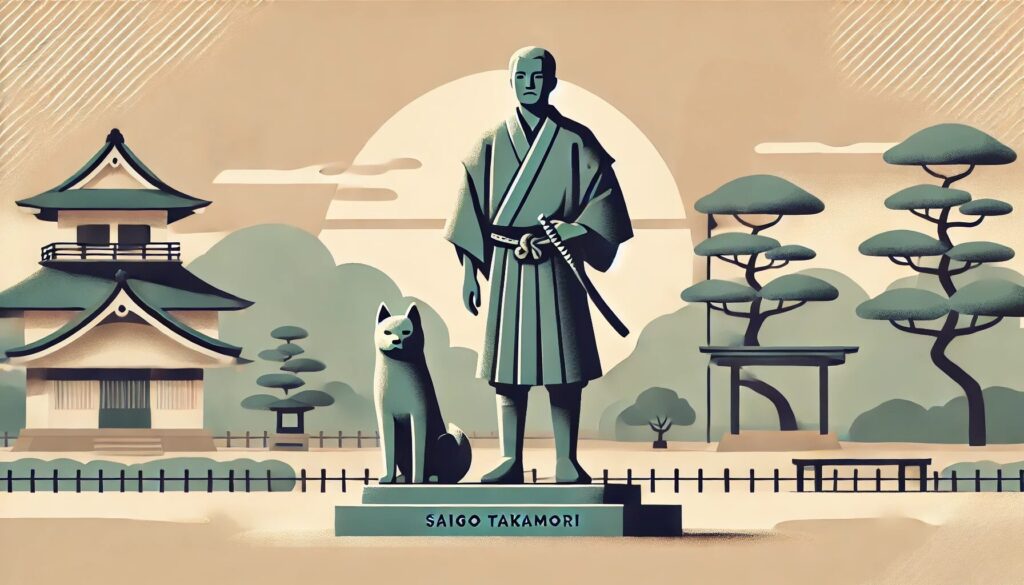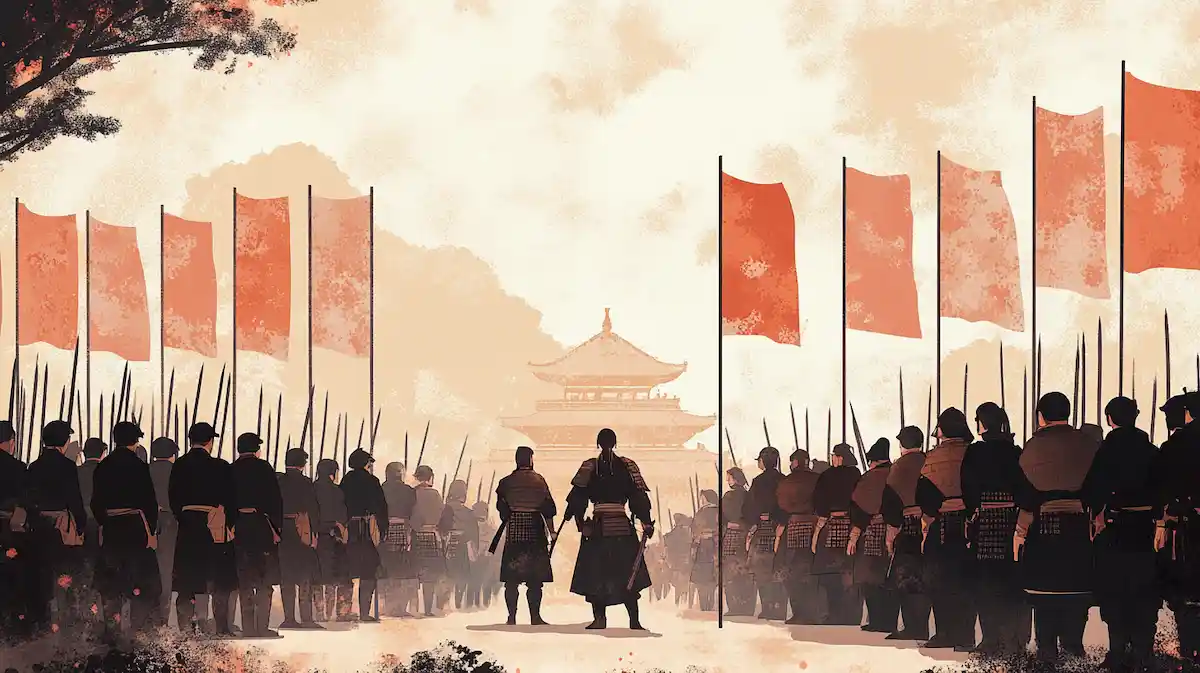西郷隆盛を英語で説明・紹介するための基本情報と、英会話に役立つ表現をシンプルでわかりやすい英語で紹介します。
英会話ダイアローグ・関連情報・10の質問を通して、西郷隆盛に関する英語表現を学びます。
英語
英会話ダイアローグを読む前に知っておくと良い前提知識と情報です。
- 西郷隆盛の生涯と背景
- 江戸時代末期から明治初期にかけて活躍した薩摩藩の武士・政治家
- 薩摩藩と長州藩を結ぶ「薩長同盟」を成立させ、明治維新に大きく貢献
- 明治維新と薩長同盟
- 明治維新は江戸幕府を終わらせ、日本を近代国家に変えるための改革、西郷は中心人物の一人
- 薩長同盟の形成に、西郷は大きな役割を果たした
- 戊辰戦争と江戸城無血開城
- 戊辰戦争は幕府側と新政府側が戦った内戦、西郷は新政府軍を指揮し勝利に導いた
- 西郷は幕府の勝海舟と交渉し、江戸城を戦わずに明け渡す「無血開城」を実現
- 征韓論と西南戦争
- 征韓論は朝鮮を武力で開国させようとする政策、政府内で対立が起こり西郷は政府を離れた
- 1877年の西南戦争は西郷と政府に不満を持つ士族たちが起こした反乱、西郷は敗れ自ら命を絶った
- 西郷隆盛の死後の評価と現在の人気
- 西郷は「最後の武士」として尊敬され、彼の忠義や勇気は今でも愛されている
- 上野公園には西郷の銅像が立っており、羽織袴姿で愛犬と共に立つ姿が彼の人柄を象徴
2人が西郷隆盛について話しています。
薩長同盟から西南戦争での最期まで、西郷の生涯の重要な出来事、人物像、上野公園の銅像などを話題にしています。
会話 / dialogue

Hey Key, I’ve been interested in learning more about Saigo Takamori. He’s such a famous figure in Japan, but there’s so much I don’t know about him.

That’s a great choice! Saigo is often seen as a symbol of the samurai spirit, especially from a Western perspective. Do you know much about his life?

Not really, but I know he helped change Japan. Could you tell me more about his role?

Sure! Saigo was born in Satsuma, which is now Kagoshima. He wasn’t from the highest-ranking samurai class but was actually a goshi, or a samurai landowner. His strong sense of justice and leadership made him a respected figure in his domain. One of his biggest achievements was forming the “Satcho Alliance.”

The Satcho Alliance? What was that?

It was an alliance between Satsuma and Choshu, two powerful domains. Saigo brought them together to fight against the Tokugawa shogunate, which ruled Japan at the time. This alliance was key to overthrowing the shogunate and starting the Meiji era.

That sounds like a big deal. So, he helped end the old government?

Exactly. And he was a leader in the Boshin War, the civil war between the shogunate and the new government. Saigo led the government’s army to victory, which allowed Japan to enter a new, modern era.

Wow, he must have been really respected for that. But didn’t he have some issues with the new government?

Yes, that’s right. After the new government was formed, Saigo took a high position, but he soon disagreed with the government’s policies. One big issue was whether to use force to open up Korea to trade. Saigo thought it was necessary, but other leaders disagreed.

So, he couldn’t agree with them and decided to leave?

Yes. Saigo valued loyalty and honesty, and when he felt the government was going in a different direction, he left and returned to Kagoshima. But his story didn’t end there.

Right, I heard he started the Satsuma Rebellion. What was that about?

The Satsuma Rebellion happened in 1877. Saigo led a group of samurai who were unhappy with the government’s changes, especially the loss of samurai privileges. It was a last stand for the samurai way of life, but unfortunately, they lost, and Saigo took his own life in the final battle.

That sounds like a tragic end, but also brave. He really stood by his beliefs, didn’t he?

Absolutely. His loyalty and courage are why he’s remembered as a symbol of the samurai spirit. Even though he fought against the government in the end, many people respect him for staying true to himself.

I can see why he’s so admired. I heard there’s a statue of him in Ueno Park. Have you seen it?

Yes, I have! It’s an impressive statue – it shows him wearing traditional haori and hakama clothing, with his loyal dog by his side. His calm, steady stance makes him look relatable and approachable.

That’s interesting. So, he’s remembered as a real person, not just a samurai?

Exactly. People admire his achievements, but they also see him as a humble, loyal person. That’s why his legacy is so strong. The statue in Kagoshima also attracts many people who want to pay their respects.

I’d love to visit those places and learn more. Saigo’s life seems like a story of loyalty and courage. He really followed his beliefs to the end.

He did, and that’s why he’s a timeless figure in Japan. Even after his death, he was pardoned by Emperor Meiji, which restored his honor. Now, people see him as a hero.

That’s amazing. I think learning about Saigo has deepened my understanding of Japanese history and culture. He’s more than just a historical figure—he’s like a role model.

I agree. Saigo Takamori’s story is inspiring and teaches us a lot about loyalty, courage, and the strength to follow our beliefs.

Thanks, Key. Now I really feel motivated to read more and even visit Ueno Park to see his statue.

You should! It’s a great way to feel connected to his story. Saigo Takamori will definitely stay in your mind once you get to know him.
関連情報 / related information
「西郷隆盛」について、理解を深めるための「英語での関連情報」です。
西郷隆盛

Early Life and Background
Saigo Takamori was born in 1828 in Satsuma, which is now Kagoshima Prefecture in Japan. He was born into a family of lower-ranked samurai called goshi, or samurai landowners. Despite his rank, Saigo became known for his strong sense of justice and leadership.
Role in the Meiji Restoration
Saigo played a major role in the Meiji Restoration, a movement to modernize Japan and end the rule of the Tokugawa shogunate. He helped create the “Satcho Alliance” between the Satsuma and Choshu domains, two powerful regions. This alliance was key to defeating the shogunate and starting a new government.
Conflict with the New Government
After the new government was formed, Saigo became one of its leaders but soon disagreed with its policies, especially on foreign relations with Korea. This disagreement led him to leave the government and return to Kagoshima.
The Satsuma Rebellion and Legacy
In 1877, Saigo led the Satsuma Rebellion, a final stand for the samurai who were unhappy with the new government’s policies. The rebellion failed, and Saigo died in the final battle. Today, Saigo is remembered as “The Last Samurai,” and statues of him, especially in Ueno Park, Tokyo, honor his courage and loyalty.
10の質問 / 10 questions
「西郷隆盛」について、理解を深めるための「英語での10の質問」です。
1: Who was Saigo Takamori?
Saigo Takamori was a Japanese samurai and leader during the late Edo and early Meiji periods. He is known for his role in the Meiji Restoration and is sometimes called “The Last Samurai.”
2: Where was Saigo Takamori born?
Saigo was born in Satsuma, which is now Kagoshima Prefecture in Japan. He came from a samurai family of lower rank called goshi, or samurai landowners.
3: What is the Meiji Restoration?
The Meiji Restoration was a period of change when Japan modernized and ended the rule of the Tokugawa shogunate. Saigo was a key figure in this transformation.
4: What is the Satcho Alliance?
The Satcho Alliance was an alliance between Satsuma and Choshu domains, formed by Saigo and other leaders to overthrow the Tokugawa shogunate. It was essential to the success of the Meiji Restoration.
5: What was Saigo’s role in the Boshin War?
Saigo was the main commander of the new government’s army in the Boshin War, a civil war between the shogunate and the new government. He led the government to victory, which helped end the shogunate’s rule.
6: Why did Saigo leave the government?
Saigo disagreed with the new government’s policies, especially regarding foreign relations with Korea. When he couldn’t agree with their direction, he decided to leave and returned to Kagoshima.
7: What was the Satsuma Rebellion?
The Satsuma Rebellion was a revolt led by Saigo in 1877. He and other samurai opposed the new government’s policies and the loss of samurai privileges. Unfortunately, the rebellion ended in defeat.
8: How did Saigo Takamori die?
Saigo died during the final battle of the Satsuma Rebellion. He took his own life, which marked the end of his fight against the new government.
9: Why is Saigo called “The Last Samurai”?
Saigo is called “The Last Samurai” because he represented the traditional values of the samurai, like loyalty and bravery. His life is seen as a symbol of the samurai spirit.
10: Where can you find a statue of Saigo Takamori?
A famous statue of Saigo is in Ueno Park in Tokyo. The statue shows him in traditional clothing with his dog, representing his approachable and humble personality.

和訳付
会話 / dialogue

Hey Key, I’ve been interested in learning more about Saigo Takamori. He’s such a famous figure in Japan, but there’s so much I don’t know about him.
ねえ、キー。最近、西郷隆盛についてもっと知りたくなってさ。日本でとても有名な人だけど、まだ分からないことがたくさんあるんだよね。

That’s a great choice! Saigo is often seen as a symbol of the samurai spirit, especially from a Western perspective. Do you know much about his life?
いいね!西郷は、特に西洋では侍精神の象徴と見なされることが多いよ。彼の生涯についてどれくらい知ってる?

Not really, but I know he helped change Japan. Could you tell me more about his role?
あまり詳しくは知らないけど、日本を変えるのに貢献したってことは知ってるよ。彼の役割についてもっと教えてくれる?

Sure! Saigo was born in Satsuma, which is now Kagoshima. He wasn’t from the highest-ranking samurai class but was actually a goshi, or a samurai landowner. His strong sense of justice and leadership made him a respected figure in his domain. One of his biggest achievements was forming the “Satcho Alliance.”
もちろん!西郷は薩摩、今の鹿児島で生まれたんだ。最上級の侍じゃなかったけど、郷士といって、侍の土地所有者の身分だったんだ。正義感とリーダーシップの強さで地元では尊敬されていたよ。彼の大きな功績のひとつが「薩長同盟」を結んだことなんだ。

The Satcho Alliance? What was that?
薩長同盟?それって何?

It was an alliance between Satsuma and Choshu, two powerful domains. Saigo brought them together to fight against the Tokugawa shogunate, which ruled Japan at the time. This alliance was key to overthrowing the shogunate and starting the Meiji era.
薩摩と長州、当時の強力な藩の同盟だよ。西郷が彼らを結びつけて、当時日本を支配していた徳川幕府と戦うために協力させたんだ。この同盟が、幕府を倒して明治時代を始める重要なきっかけになったんだ。

That sounds like a big deal. So, he helped end the old government?
それってすごいね。つまり彼は旧政府を終わらせる手助けをしたんだね?

Exactly. And he was a leader in the Boshin War, the civil war between the shogunate and the new government. Saigo led the government’s army to victory, which allowed Japan to enter a new, modern era.
その通り。そして彼は戊辰戦争でもリーダーを務めたんだよ。これは幕府と新政府の間の内戦で、西郷が率いた政府軍が勝利して、日本が新しい近代時代に入ることができたんだ。

Wow, he must have been really respected for that. But didn’t he have some issues with the new government?
すごいね、それで彼は本当に尊敬されただろうね。でも、新政府と何か問題があったんじゃない?

Yes, that’s right. After the new government was formed, Saigo took a high position, but he soon disagreed with the government’s policies. One big issue was whether to use force to open up Korea to trade. Saigo thought it was necessary, but other leaders disagreed.
うん、その通り。新政府ができた後、西郷は高い地位に就いたんだけど、すぐに政府の政策に反対したんだ。特に大きな問題は、韓国を開国させるために武力を使うべきかどうかってこと。西郷は必要だと思ったけど、他の指導者たちは反対だったんだ。

So, he couldn’t agree with them and decided to leave?
だから、彼は同意できなくて、辞めることにしたんだね?

Yes. Saigo valued loyalty and honesty, and when he felt the government was going in a different direction, he left and returned to Kagoshima. But his story didn’t end there.
そうなんだ。西郷は忠義と誠実さを大事にしていて、政府が違う方向に進んでいると感じたときに辞めて、鹿児島に戻ったんだ。でも彼の物語はそれで終わらなかったんだよ。

Right, I heard he started the Satsuma Rebellion. What was that about?
そうだね、彼が西南戦争を始めたって聞いたよ。それってどういうことだったの?

The Satsuma Rebellion happened in 1877. Saigo led a group of samurai who were unhappy with the government’s changes, especially the loss of samurai privileges. It was a last stand for the samurai way of life, but unfortunately, they lost, and Saigo took his own life in the final battle.
西南戦争は1877年に起こったんだ。西郷は、特に侍の特権が失われることに不満を持っていた侍たちを率いて政府に反抗したんだ。それは侍の生き方の最後の抵抗だったんだけど、残念ながら敗れて、西郷は最後の戦いで自ら命を絶ったんだ。

That sounds like a tragic end, but also brave. He really stood by his beliefs, didn’t he?
悲劇的な結末だけど、勇敢だね。彼は本当に自分の信念を貫いたんだね。

Absolutely. His loyalty and courage are why he’s remembered as a symbol of the samurai spirit. Even though he fought against the government in the end, many people respect him for staying true to himself.
まさにそうだよ。彼の忠義と勇気こそが、彼を侍精神の象徴として記憶される理由なんだ。最後は政府と戦ったけど、自分を貫いたことで多くの人に尊敬されているんだ。

I can see why he’s so admired. I heard there’s a statue of him in Ueno Park. Have you seen it?
なるほど、だから彼がすごく尊敬されているんだね。上野公園に彼の銅像があるって聞いたけど、見たことある?

Yes, I have! It’s an impressive statue – it shows him wearing traditional haori and hakama clothing, with his loyal dog by his side. His calm, steady stance makes him look relatable and approachable.
うん、見たことあるよ!印象的な銅像だよ。彼が羽織袴を着て、忠犬を連れている姿が描かれているんだ。落ち着いた姿勢で親しみやすく見えるんだよ。

That’s interesting. So, he’s remembered as a real person, not just a samurai?
面白いね。つまり、彼はただの侍じゃなくて、親しみやすい人物として記憶されているんだね?

Exactly. People admire his achievements, but they also see him as a humble, loyal person. That’s why his legacy is so strong. The statue in Kagoshima also attracts many people who want to pay their respects.
そうそう。人々は彼の功績を尊敬しているけど、謙虚で忠義のある人物としても見ているんだ。それが彼の影響力が今も続いている理由だよ。鹿児島の銅像も多くの人が敬意を表すために訪れているよ。

I’d love to visit those places and learn more. Saigo’s life seems like a story of loyalty and courage. He really followed his beliefs to the end.
そういう場所に行ってもっと学びたいな。西郷の人生って、忠義と勇気の物語みたいだね。彼は本当に最後まで自分の信念を貫いたんだね。

He did, and that’s why he’s a timeless figure in Japan. Even after his death, he was pardoned by Emperor Meiji, which restored his honor. Now, people see him as a hero.
そうなんだ。だからこそ彼は日本で時代を超えた存在なんだよ。彼が亡くなった後、明治天皇によって赦免されて名誉が回復されたんだ。今では英雄として見られているよ。

That’s amazing. I think learning about Saigo has deepened my understanding of Japanese history and culture. He’s more than just a historical figure—he’s like a role model.
すごいね。西郷について学ぶことで、日本の歴史や文化についての理解が深まった気がする。彼はただの歴史上の人物じゃなくて、ロールモデルのような存在だね。

I agree. Saigo Takamori’s story is inspiring and teaches us a lot about loyalty, courage, and the strength to follow our beliefs.
本当にそうだね。西郷隆盛の物語は、とても刺激的で、忠義や勇気、信念を貫く強さについて多くを教えてくれるよ。

Thanks, Key. Now I really feel motivated to read more and even visit Ueno Park to see his statue.
ありがとう、キー。もっと読んでみたくなったし、上野公園の銅像も実際に見に行ってみたくなったよ。

You should! It’s a great way to feel connected to his story. Saigo Takamori will definitely stay in your mind once you get to know him.
ぜひ行ってみて!彼の物語とつながりを感じる良い機会になると思うよ。西郷隆盛のことを知れば、きっと心に残る人物になるよ。
関連情報 / related information
西郷隆盛

Early Life and Background
Saigo Takamori was born in 1828 in Satsuma, which is now Kagoshima Prefecture in Japan. He was born into a family of lower-ranked samurai called goshi, or samurai landowners. Despite his rank, Saigo became known for his strong sense of justice and leadership.
幼少期と背景
西郷隆盛は1828年に薩摩(現在の鹿児島県)で生まれました。彼は、土地を所有する侍である「郷士」と呼ばれる下級武士の家に生まれました。身分は高くなかったものの、西郷は強い正義感とリーダーシップで知られるようになりました。
Role in the Meiji Restoration
Saigo played a major role in the Meiji Restoration, a movement to modernize Japan and end the rule of the Tokugawa shogunate. He helped create the “Satcho Alliance” between the Satsuma and Choshu domains, two powerful regions. This alliance was key to defeating the shogunate and starting a new government.
明治維新での役割
西郷は日本を近代化し、徳川幕府の支配を終わらせるための明治維新において重要な役割を果たしました。彼は薩摩藩と長州藩という強力な二つの藩を結びつけ、「薩長同盟」を成立させました。この同盟は幕府を打倒し、新しい政府を立ち上げるための大きな力となりました。
Conflict with the New Government
After the new government was formed, Saigo became one of its leaders but soon disagreed with its policies, especially on foreign relations with Korea. This disagreement led him to leave the government and return to Kagoshima.
新政府との対立
新政府が成立した後、西郷はその指導者の一人となりましたが、すぐに政策に対立するようになりました。特に、朝鮮との外交方針に関して意見が合わず、この対立が原因で政府を離れ、鹿児島に戻りました。
The Satsuma Rebellion and Legacy
In 1877, Saigo led the Satsuma Rebellion, a final stand for the samurai who were unhappy with the new government’s policies. The rebellion failed, and Saigo died in the final battle. Today, Saigo is remembered as “The Last Samurai,” and statues of him, especially in Ueno Park, Tokyo, honor his courage and loyalty.
西南戦争とその遺産
1877年、西郷は新政府の政策に不満を持つ侍たちと共に西南戦争を起こしました。この反乱は失敗し、最終戦で西郷は命を落としました。現在、西郷は「最後の侍」として記憶され、特に東京の上野公園にある銅像は彼の勇気と忠義を称えています。
10の質問 / 10 questions
1: Who was Saigo Takamori?
西郷隆盛とは誰ですか?
Saigo Takamori was a Japanese samurai and leader during the late Edo and early Meiji periods. He is known for his role in the Meiji Restoration and is sometimes called “The Last Samurai.”
西郷隆盛は江戸時代後期から明治時代初期に活躍した日本の武士であり指導者です。明治維新での役割で知られ、「最後の武士」とも呼ばれることがあります。
2: Where was Saigo Takamori born?
西郷隆盛はどこで生まれましたか?
Saigo was born in Satsuma, which is now Kagoshima Prefecture in Japan. He came from a samurai family of lower rank called goshi, or samurai landowners.
西郷は薩摩(現在の鹿児島県)で生まれました。彼は「郷士」と呼ばれる下級武士の家に生まれました。
3: What is the Meiji Restoration?
明治維新とは何ですか?
The Meiji Restoration was a period of change when Japan modernized and ended the rule of the Tokugawa shogunate. Saigo was a key figure in this transformation.
明治維新は、日本が近代化し、徳川幕府の支配が終わった変革の時期です。西郷はこの変革の中心人物でした。
4: What is the Satcho Alliance?
薩長同盟とは何ですか?
The Satcho Alliance was an alliance between Satsuma and Choshu domains, formed by Saigo and other leaders to overthrow the Tokugawa shogunate. It was essential to the success of the Meiji Restoration.
薩長同盟は、徳川幕府を倒すために西郷や他の指導者が結成した薩摩藩と長州藩の同盟です。明治維新の成功には欠かせないものでした。
5: What was Saigo’s role in the Boshin War?
戊辰戦争での西郷の役割は何ですか?
Saigo was the main commander of the new government’s army in the Boshin War, a civil war between the shogunate and the new government. He led the government to victory, which helped end the shogunate’s rule.
戊辰戦争では、西郷が新政府軍の総司令官を務め、幕府と新政府の内戦を戦いました。彼は政府軍を勝利に導き、幕府の支配を終わらせることに貢献しました。
6: Why did Saigo leave the government?
なぜ西郷は政府を離れたのですか?
Saigo disagreed with the new government’s policies, especially regarding foreign relations with Korea. When he couldn’t agree with their direction, he decided to leave and returned to Kagoshima.
西郷は新政府の政策、特に朝鮮との外交に関して反対していました。政府の方針に同意できなかったため、政府を離れて鹿児島に戻ることを決めました。
7: What was the Satsuma Rebellion?
西南戦争とは何ですか?
The Satsuma Rebellion was a revolt led by Saigo in 1877. He and other samurai opposed the new government’s policies and the loss of samurai privileges. Unfortunately, the rebellion ended in defeat.
西南戦争は1877年に西郷が指導した反乱です。彼と他の侍たちは新政府の政策と侍の特権の喪失に反発しましたが、残念ながら反乱は敗北に終わりました。
8: How did Saigo Takamori die?
西郷隆盛はどのように亡くなりましたか?
Saigo died during the final battle of the Satsuma Rebellion. He took his own life, which marked the end of his fight against the new government.
西郷は西南戦争の最後の戦いで命を落としました。彼は自決し、新政府に対する戦いの終わりを迎えました。
9: Why is Saigo called “The Last Samurai”?
なぜ西郷は「最後の侍」と呼ばれるのですか?
Saigo is called “The Last Samurai” because he represented the traditional values of the samurai, like loyalty and bravery. His life is seen as a symbol of the samurai spirit.
西郷は忠義や勇敢さといった侍の伝統的な価値を体現していたため、「最後の侍」と呼ばれています。彼の生涯は侍精神の象徴とされています。
10: Where can you find a statue of Saigo Takamori?
西郷隆盛の銅像はどこで見られますか?
A famous statue of Saigo is in Ueno Park in Tokyo. The statue shows him in traditional clothing with his dog, representing his approachable and humble personality.
西郷の有名な銅像は東京の上野公園にあります。この銅像では、彼が伝統的な衣装を着て犬と一緒に立っており、親しみやすく謙虚な人柄を表しています。

words & phrases
英会話ダイアローグと関連情報に出てきた単語・フレーズです(例文は各3つ)。

alliance : 名詞
意味: 提携、同盟。An agreement between groups or countries to work together for a common goal.
(西郷隆盛が結成した「薩長同盟」を指す)
例文:
- Japan and the United States formed an alliance during the 20th century.
「日本とアメリカは20世紀に同盟を結びました。」 - The two companies are in an alliance to develop new technology.
「その二社は新技術を開発するために提携しています。」 - The political parties made an alliance to gain more influence.
「政党はより大きな影響力を得るために同盟を結びました。」
privilege : 名詞
意味: 特権、恩恵。A special right or advantage given to a particular person or group.
(西郷が新政府によって侍の特権が失われることに反発したことを示す)
例文:
- Only members have the privilege to use this facility.
「メンバーだけがこの施設を利用する特権を持っています。」 - It’s a privilege to be able to study abroad.
「留学できることは特権です。」 - The manager has the privilege to make final decisions.
「マネージャーには最終決定を下す特権があります。」
relatable : 形容詞
意味: 共感できる、親近感がわく。Easy to connect with or understand because it feels familiar.
(上野公園の西郷隆盛の銅像が、親しみやすさを象徴していることを指す)
例文:
- The character in the movie was very relatable to the audience.
「その映画のキャラクターは観客にとても共感されました。」 - Her story was relatable, making everyone feel close to her.
「彼女の話は共感できるもので、皆が親近感を感じました。」 - The teacher’s approach was relatable to the students.
「先生の教え方は学生に親しみやすいものでした。」
humble : 形容詞
意味: 謙虚な、控えめな。Having a modest or low view of one’s importance.
(西郷隆盛が地位や名声を追求せず、謙虚な態度で人々に親しまれたことを示す)
例文:
- She remained humble despite her success.
「彼女は成功しても謙虚なままでした。」 - He came from humble beginnings but achieved great things.
「彼は控えめな出自から大きな成功を収めました。」 - The award winner gave a humble speech.
「受賞者は謙虚なスピーチをしました。」
timeless : 形容詞
意味: 時を超えた、永遠の。Not affected by the passage of time; lasting forever.
(西郷隆盛の教えや影響が時代を超えて続いていることを表す)
例文:
- The book’s message is timeless and still relevant today.
「その本のメッセージは時を超えて、今でも価値があります。」 - His art has a timeless quality that appeals to everyone.
「彼の芸術は時代を超えた魅力があり、誰にでも響きます。」 - Friendship is a timeless bond that lasts a lifetime.
「友情は一生続く時を超えた絆です。」
詳細情報 / Further Info
関連記事(明治維新)

